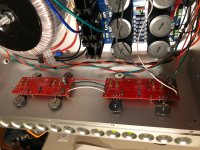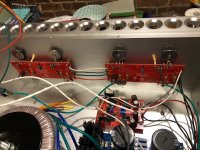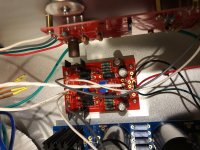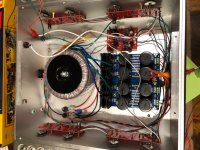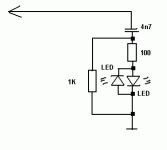I'm desperate for some help guys.
I've finished my F5 Turbo monoblocks. They pass the dim bulb test. They bias beautifully with almost no DC offset.
Twice, however, I've blown the outputs on startup and had to replaced all the mosfets (which is getting expensive).
The issue seems to be that wherever I set the bias, that I when I turn the amp on cold, the bias jumps much higher on startup.
Twice I biased it perfectly and then after the amp was cold and I turned it on---- POOF.
The third time I set the bias very low, around 125mv, let it sit for a while, and then on startup the bias starts around 350mv and slowly drops down to the set range.
I'm pretty sure that when I biased it around 300mv, the bias jumped to over 600mv when started up cold.
The issue is not the outputs (just installed) or the 1ohm resistors (just replaced them. Could it be an issue with the diodes? I have not replaced those, but I'm doubtful that they could have blown.
Any other ideas on what to check or replace? Like I said, the thing is so stable and biases perfectly. The only issue is on startup.
Would be so grateful for any help.
I've finished my F5 Turbo monoblocks. They pass the dim bulb test. They bias beautifully with almost no DC offset.
Twice, however, I've blown the outputs on startup and had to replaced all the mosfets (which is getting expensive).
The issue seems to be that wherever I set the bias, that I when I turn the amp on cold, the bias jumps much higher on startup.
Twice I biased it perfectly and then after the amp was cold and I turned it on---- POOF.
The third time I set the bias very low, around 125mv, let it sit for a while, and then on startup the bias starts around 350mv and slowly drops down to the set range.
I'm pretty sure that when I biased it around 300mv, the bias jumped to over 600mv when started up cold.
The issue is not the outputs (just installed) or the 1ohm resistors (just replaced them. Could it be an issue with the diodes? I have not replaced those, but I'm doubtful that they could have blown.
Any other ideas on what to check or replace? Like I said, the thing is so stable and biases perfectly. The only issue is on startup.
Would be so grateful for any help.
see 2 issues
NTC must have impeccable thermal contact with mosfet, when so much depends of thermal behavior - say that I did found that place with greatest temp. change is drain pin, close to mosfet body
say that I would arrange NTC almost touching there, with blob of thermal grease in between
second - much more serious issue - I would be scared to even power ON , amplifier having so long wires in between FE and OS
call me a Chicken but, with my luck, that amp would not only go dead whenever I power it ON, it would chase me with pitchforks, for revenge
NTC must have impeccable thermal contact with mosfet, when so much depends of thermal behavior - say that I did found that place with greatest temp. change is drain pin, close to mosfet body
say that I would arrange NTC almost touching there, with blob of thermal grease in between
second - much more serious issue - I would be scared to even power ON , amplifier having so long wires in between FE and OS
call me a Chicken but, with my luck, that amp would not only go dead whenever I power it ON, it would chase me with pitchforks, for revenge
Would the NTC mounting potentially cause the bias to go higher at startup? Seems very odd? Could a mismatched mosfet explain it?
I understand the desire for a shorter connection, but I had space issues. Why would a few extra inches of wire risk the amp going dead? Aside from any degradation in sound quality.
I understand the desire for a shorter connection, but I had space issues. Why would a few extra inches of wire risk the amp going dead? Aside from any degradation in sound quality.
tighter (thermally) the mounting of NTCs would result in smaller Iq difference in temperature domain, due to greater thermal difference NTC could feel, simple as that
though, it would be wise to check, in some way, is there oscillation as problem
scope is pretty much sure and only tool for that, even if sometimes this thingie (attached), connected to output, could help ...... but when this is capable to show oscillations, amp is already deep in trouble
have lag caps, across feedback resistors?
though, it would be wise to check, in some way, is there oscillation as problem
scope is pretty much sure and only tool for that, even if sometimes this thingie (attached), connected to output, could help ...... but when this is capable to show oscillations, amp is already deep in trouble
have lag caps, across feedback resistors?
Attachments
I added thermal paste and repositioned but no noticeable change. Could the NTCs have been damaged when I blew the outputs?
I did not consider replacing them. Any thing else other than the source resistors that could have likely been damaged? Other resistor on output boards?
I did not consider replacing them. Any thing else other than the source resistors that could have likely been damaged? Other resistor on output boards?
There are a couple of posts on the F5 and F5t threads that have had output device failures. Cause was thermistor shorting to ground because of contact to fender washer and not the plastic case of MOSFET.
easy to check ntc with ohmmeter, but out of circuit
cold, close to nominal value
take them in fingers, resistance drops
with reposition, you should see a change in final Iq, in thermal equilibrium, versus previous positioning ...... so when you re-bias, it would be change in starting values
what with lag caps?
cold, close to nominal value
take them in fingers, resistance drops
with reposition, you should see a change in final Iq, in thermal equilibrium, versus previous positioning ...... so when you re-bias, it would be change in starting values
what with lag caps?
at least C3 and C4 , as shown on V3 schematic , page 13 of article
some cases maybe could benefit from caps across R7 and R10 ( say 15nF is appropriate) , ref. to same schmtc
some cases maybe could benefit from caps across R7 and R10 ( say 15nF is appropriate) , ref. to same schmtc
Last edited:
I have C3 and C4 installed and used 1000pf in accordance with recommendation in the build guide.
One other thought, instead of 2SC4793 and 2SA1837, which are no longer available, I used TTC011BQ and TA006BQ. Any potential issue there?
One other thought, instead of 2SC4793 and 2SA1837, which are no longer available, I used TTC011BQ and TA006BQ. Any potential issue there?
I'm willing to break these amps down and test/replace anything that could be causing this problem, but I just don't know what could cause the bias to jump like that at the start and then slowly fall.
I monitored the power supply on start up and it the voltage is around 36 or 37V at that initial startup and then rises to the stable voltage of 41V as the bias drops down to its stable level. Not sure if this information adds anything.
I also realized that because this issue is happening in both monoblocks, it is probably not one bad part. It must be something to do with my part choices or build.
I monitored the power supply on start up and it the voltage is around 36 or 37V at that initial startup and then rises to the stable voltage of 41V as the bias drops down to its stable level. Not sure if this information adds anything.
I also realized that because this issue is happening in both monoblocks, it is probably not one bad part. It must be something to do with my part choices or build.
Last edited:
try to find someone locally, to help you with scope and determine are there oscillations or not
other way is to install these 15nF caps I mentioned, hoping they'll cure potential oscill.
then , when knowing about that , you can try increasing influence of NTCs itself, say with decreasing/shorting R11 and R12, with necessary rebiasing after that
other way is to install these 15nF caps I mentioned, hoping they'll cure potential oscill.
then , when knowing about that , you can try increasing influence of NTCs itself, say with decreasing/shorting R11 and R12, with necessary rebiasing after that
I see one more problem. you have 1 thermistor on each output board. you should only use ONE NTC for N-ch and ONE NTC for P-ch for each amp channel. Also, as ZM said, mount them directly on the mosfets body. They can so easy short out when tuching metal. Now they are mounted on STEEL washers. Steel takes time to heat up, so the bias vil rise untill the NTC's are sensing the heat.
Last edited:
Could a mismatched mosfet explain it?
Are the Mosfets matched?
Audiosan's advice seemed to help. Once I removed the second set of thermistor's the difference between the spike and the stable bias dropped a lot.
As currently biased, it starts off rising quickly to 380mv or so and then stabilizes around 250mv. I'd like to be able to bias at 300mv, so what would be an acceptable spike that won't risk any wort of blow-up?
I may test it with cheap speakers this morning to see how it sounds with the current 250mv bias.
I bought matched mosfets, but I've bought matched mosfets before that didn't always end up being matched. I did not build the 15V jig necessary to test them all again myself. But I really don't think that is the issue because this behavior is on both amps and I replaced them twice with other matched sets. Unlikely the error carried over.
I suspect the extra thermistor was doing something weird.
Props to Audiosan for a very good eye.
As currently biased, it starts off rising quickly to 380mv or so and then stabilizes around 250mv. I'd like to be able to bias at 300mv, so what would be an acceptable spike that won't risk any wort of blow-up?
I may test it with cheap speakers this morning to see how it sounds with the current 250mv bias.
I bought matched mosfets, but I've bought matched mosfets before that didn't always end up being matched. I did not build the 15V jig necessary to test them all again myself. But I really don't think that is the issue because this behavior is on both amps and I replaced them twice with other matched sets. Unlikely the error carried over.
I suspect the extra thermistor was doing something weird.
Props to Audiosan for a very good eye.
- Home
- Amplifiers
- Pass Labs
- Help Needed with F5 Turbo V3 Monoblock Bias Issue on Startup
